Astana is another wonder of the world
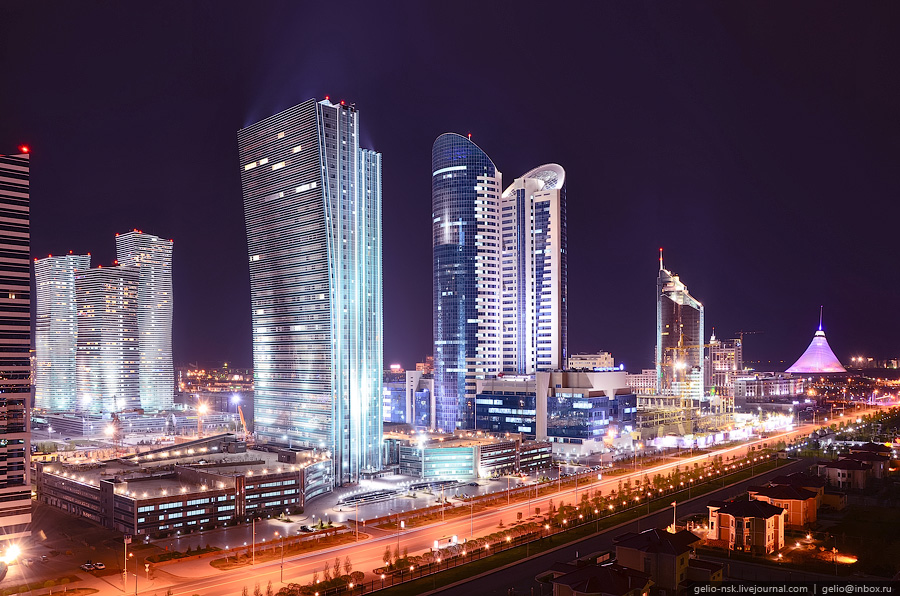
In 1997, the President of sovereign Kazakhstan, Nursultan Nazarbayev, suggested to move the capital from Almaty to Akmola. This decision was based on the important geo-political location of the city in the center of Kazakhstan and the Eurasian continent as well as on the availability of transport and communication infrastructure. The capital's new location was also chosen for the availability of space and land which would allow the city to develop.
It was once said that "the West is the West, the East is the East and they will never be together". In Kazakhstan there is a city which disproves this saying that seemed irrefutable.
In 1998 the new capital was renamed. It was given the name "Astana", which stands for "Capital" in Kazakh.
The entire world built Astana
The young capital which changes as we watch is the symbol of creation, creativity and progress of the Kazakh people.
|
71 |
432 |
135 |
|
cities |
construction companies |
construction companies |
supplying construction materials took part in building Astana.
Together with local companies, the new capital was built by Turkish, Italian, French and Swiss companies. Every year 60 to 100 middle and large size facilities were built. Rapid construction and widespread popular support made it possible to build a modern city of unique beauty and style in the steppes of Kazakhstan in the space of 10 years.
The world's best architects built Astana
The architectural concept of the city was based on President Nursultan Nazarbayev's idea that the city should have a Eurasian outlook.
The author of the general plan of Astana was the famous Japanese architect, Kisho Kurokawa, who designed the Van Gogh museum in Amsterdam, the International Airport of Kuala Lumpur and the national ethnological museum in Osaka.
The architectural ensembles created in accordance with Kurokawa's general design combine modern design and oriental flavor. This makes the city unique. The beauty and the height of buildings in the city are comparable with Tokyo, New York and Dubai.
Norman Foster designed and built Astana's unique House of World's Religions, the Palace of Peace. The architect's team also built the capital's new entertainment center, the "Khan Shatyr".
Astana is part of Kazakhstani's Brand
In July 1999, Astana was awarded a UNESCO "city for peace" prize. The new capital has all the fundamental characteristics reasons to become one of the world's 30 best cities.
Kazakhstan's modern capital is continuously growing and changing. It is becoming increasingly attractive both for the people of Kazakhstan and for foreign visitors. Its modern architecture, which combines the best European and oriental traditions, fully reflects the new capital's role as an economic, political and cultural center.
The city's appearance changes fast as it continues its dynamic development. The city also looks different at night, with beautifully illuminated buildings, street lights, garlands, colorful fountains on the River Ishim, nightlights along the bank, bright shop windows, bars and nightclubs.
The population of Astana
Today, Astana covers an area of 710.2 square km with a population of over 700 thousand people.
Astana is a city which offers good education and good job prospects. The rapid population growth is due above all to the migration inflow of predominantly highly-skilled specialists between 20 and 45 years old. According to municipal authorities, the average salary matches the average salary in the country's oil and gas regions whilst the unemployment rate is one of the lowest in Kazakhstan. High birth and marriage rates have also contributed to Astana's natural development.
Astana is an important cultural and scientific center in Kazakhstan. It hosts the National Academy of Sciences, universities, the National Library, the National Museum, modern art galleries, the Center for Social and Economic Technologies, business centers, children's parks, and water amusements.
Astana mirrors the realities of a modern multinational and multi-confessional Kazakhstan: representatives of all races and major religions live and work together. The city has become a venue for a number of public forums dedicated to interethnic and interfaith cooperation.
Places of interest in Astana
Astana's architecture combines oriental traditions and audacious ideas of leading western architects in a harmonious yet daring way. The general plan of the city was developed by the famous Japanese architect Kisho Kurokawa, the design of the unique Palace of Peace and Concord and the "Khan Shatyr" entertainment center belong to British architect Norman Foster and the cinema and concert hall were designed by Italian architect Manfredi Nicoletti.
The city's main square is delimited by the complex of buildings made up of the Senate, the Parliament, the President's Residence and other government buildings. Around this square more than 650 buildings are under construction, including residential and public complexes.
The Palace of Peace and Concord is a unique pyramid built for centuries to come by the famous British architect Norman Foster in 2006. The pyramid is 62 meters high and was built on a 15 meter rise covering a total area of 25.5 thousand square meters. In its basement the pyramid houses an opera hall seating 1500 and in the upper part, the confessions hall. The building includes rooms for religious events, meetings of the Assembly of Kazakhstan's Peoples, museums, and an exhibition hall.

The "Khan Shatyr" trade and entertainment center is located at the opposite end of the axis from the Palace of Peace and Concord. The complex is almost 200 meters high, making it the city's highest building. Built to resemble a huge tent, its structure is made of a fine net covered with polymeric fluorine ETFE, a unique material which lets the light through and protects the inside from heat and cold. Inside, its 100 000 square meters are occupied by a vast city park, shops, movie theaters, cafes and a concert platform, where Astana residents can enjoy their free time regardless of the season or weather.
Bayterek – the Tree of Life in the center of Eurasia
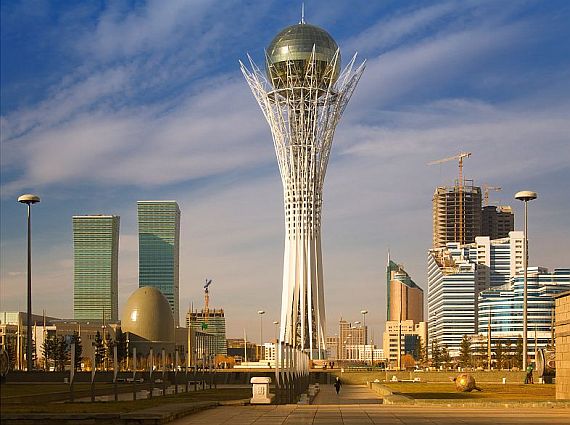
Bayterek is the capital's symbol and business card. Bayterek tower sits in the very middle of the capital's new administrative center . Everything in this monument is symbolic: the golden sun on the top of the tree, its height of 97 meters, the internal architecture divided into three zones which represent the three fundamental universal principles. This "poplar" (in Kazakh – bayterek), made of metal, glass and concrete, is architecturally unique and grandiose in appearance. It is a metal structure of 105 meters tall, 1000 tons heavy, built on five hundred poles. It is the first time that a 22 meter diameter and 300 ton sphere of "chameleon" glass, which changes color with the sunlight, is suspended at such a record-breaking height. Dominating the new capital, it is an architectural symbol of renewal, the symbol of Astana, the symbol of Kazakhstan.
Aq-Orda
Aq-Orda is the residence of the President of the Republic of Kazakhstan. It is located on the River Ishim's left bank , three hundred meters from the Bayterek monument. The building covers an area of 36 720 square meters. The official inauguration of the new Palace of the President of the Republic of Kazakhstan took place on 24 December 2004. Next to the residence are the Parliament, the House of the Government, the Supreme Court and the House of Ministries of the Republic of Kazakhstan.
Green and Water Boulevard

Along the main axis of Astana's administrative center is a pedestrian bridge, better as the "Green and Water Boulevard", brainchild of Kurokawa, the author of Astana's general plan.
The Bridge is the one of the main features of the capital's center. The architects' plans connect it to all the surrounding buildings. Designed it on three levels, it rationalizes the use of urban space as costs increase with the city's development. The lower level provides parking for 400 cars. The second level of this grandiose construction is a passage, a large gallery lined with exhibition halls, stores and offices. The third level is a pedestrian street with lawns and small trees, small architectural objects and fountains. This pedestrian bridge is notable for its six zones known as "the Green House".
Transparent conical domes let the sunlight through the building from top to bottom. In these atriums, conveniently connected with stairs, there are artificial gardens, and on the second level the whole construction is joined to the surrounding buildings by roofed galleries.
The Duman Entertainment Center
Located on the river's left bank, the Duman entertainment center hosts a unique oceanarium, a small piece of the ocean in the vast steppe. It also houses a 3D movie theater, jungles, bowling alleys, a casino, a multi-functional hall, a hotel, cafes, shops and a children's playground.
Duman is a popular place for adults and children. Visitors enjoy the watching the sharks being fed through the large glass panes of the aquarium.
Unique Stadium Astana
A new stadium was built to mark the capital's anniversary. It complies with all FIFA and UEFA requirements. The stadium covers an area of 232 485 square meters and seats 30 000 people. The stadium roof has two components, one mobile and one immobile, which function independently of each other so as to protect the stadium ground from Astana's harsh climatic conditions.
Alau Ice palace
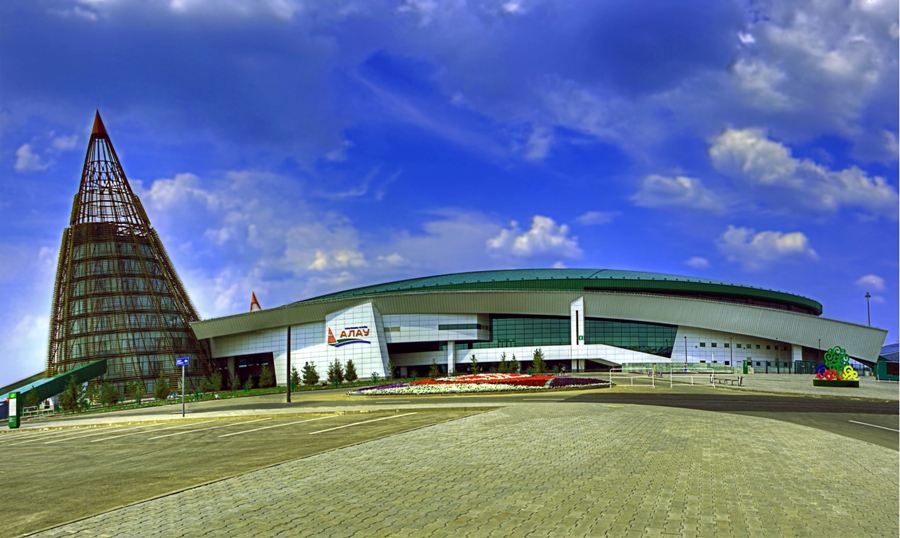
"Alau" is an ice palace of world rank, equipped with ultramodern facilities, allowing the creation of "fast ice". Thanks to a unique architecture and location, "Alau" is rightly regarded as a sightseeing attraction and the sport gates of the capital.
The heart of the Palace is the ice arena, which consists of a 400 meter ice track with stands for 8000 spectators, two ice hockey courts, a jury room, a room for press conferences and eight changing rooms for athletes.
The Palace is intended for hosting training and competitions in these sports:
• Speed skating
• Short track
• Ice hockey
• Curling
• Figure skating
Combining the modernity of the equipment and the uniqueness of the architectural project, the staff of IP "Alau" set a goal of entering the ranks of the best flatland rinks of the world. During the 7th Asian Winter Games 9 continental records were set on the Palace ice. "Alau" not only set a status as a forge for Kazakhstani records, but also took 6th place (out of 641possible places) in world rating of speed skating stadiums.
The Ice Palace holds major international competitions and training lessons. "Alau" trains students of Youth Sports Schools in speed skating, figure skating and ice hockey. After hosting the second phase of the ISU World Cup in speed skating, the champion's ice will be available to amateurs – during days of mass skating, any person wishing to skate can do so, for a symbolic price. This is the concept of mass accessibility, the task of which is to promote and popularize winter sports and contribute to the development of mass sports in Astana.
Ice Palace "Alau" is a multifunctional sports center, providing integrated services for athletes and amateurs alike.
The Circus

A huge flying saucer sits on the left bank of the Ishim River. It was made, just as a UFO should be, of super-modern materials with the help of super-modern technologies. The flying object did not remain unidentified for long: on the day of Kazakhstan's independence, it was given a name, a status and its first fans. And Astana gained a circus. Citizens fell in love with the flying saucer, and so it stays here forever.
Nur-Astana Central Mosque and Beit Rachel – Chabbad Lubavitch Synagogue
The principles of tolerance, human and religious cooperation, and unconditional respect for freedom of conscience and belief, typical of Kazakhstan, are reflected in two uniquely designed religious buildings which decorate the capital's left bank: the Nur-Astana Central Mosque and the Central Synagogue.
The mosque is surprising yet harmonious. Oriental elegance is cleverly woven into refined glass, concrete, steel, and granite designs. The size of the mosque matches the scale of other buildings on the left bank: almost four thousand square meters, with a capacity to host up to five thousand believers and another two thousand on the square in front of the mosque.
On the 21st of Elul of 5764 (7 September 2004) a new star was born in the Astana sky – the Star of David. At a height of twenty five meters, this star decorates the capital's new synagogue, the biggest in Kazakhstan and indeed in Central Asia. It covers an area of 5600 square meters and sits on the bank of the River Akbulak between the Eurasian University and a beautiful residential complex. Students of the Eurasian University, loving couples strolling down the river, yachtsmen sailing down the Rowboat Channel, all can admire the harmony of this blue and white building and its blue dome.
The Museum of the First President of the Republic of Kazakhstan
The museum is located in the former Residence of the Head of the State, N. Nazarbayev. Unique furniture and interiors have been kept intact. The museum's collection contains gifts, books and paintings presented to the President. Currently, the museum holds more than 60 thousand objects, among which manuscripts and printed materials, movies, photos, personal belongings, documents and all the First President's decorations. The museum's treasure reflects the major steps in the development of sovereign Kazakhstan and sheds light on the President's life and work.
The Museum of Modern Art
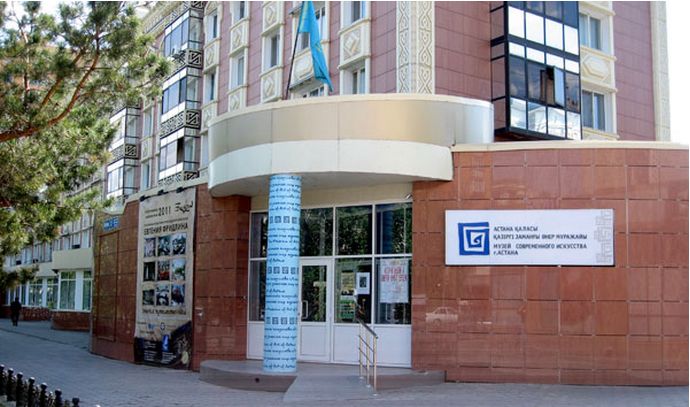
The museum's collection counts over three thousand works of art from Kazakhstan, Russia and CIS countries. It was created as a result of substantial research and a deep interest in the cultural values reflected in paintings and drawings. The museum harbours unique works by artists from Kazakhstan, Russia, Ukraine, Belarus, Uzbekistan, Georgia, Armenia, Latvia, Lithuania, Estonia, Tajikistan and other countries. The museum’s objects reflect all artistic genres and techniques as well as varied themes.
Borovoye – a world class resort
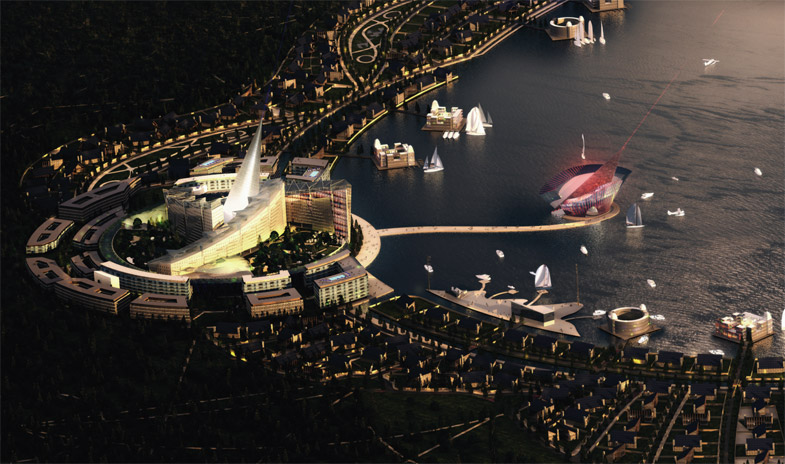
Astana will soon become a touristic hub. Not far from the capital, the unique Borovoye Lakes Resort project is being designed by the famous British architect Eric Kuhne. He believes that Borovoye is comparable to some of the world's resorts such as the Alps, the Andes, and the Rocky Mountains in the USA. "If the resort runs at full capacity, Borovoye could host a quarter of the country's population of Kazakhstan for their holidays" says the British architect. He estimated that with correct planning, the Borovoye project could host over 90 million tourists a year, including gamblers. Borovoye could also become a gaming capital, accommodating casinos "removed" from other cities around the country.
The new capital is a harmonious combination of a rich historical legacy and the best achievement of modernity. It has sights of interest to both antique lovers and high tech fans. The city's architects have said that this is only a part of the grandiose plan. In the near future the new capital will be glorious and known as one of the most beautiful city in the world.

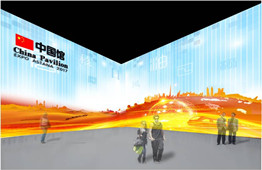 Province Events
Province Events Major Events
Major Events Highlights
Highlights
